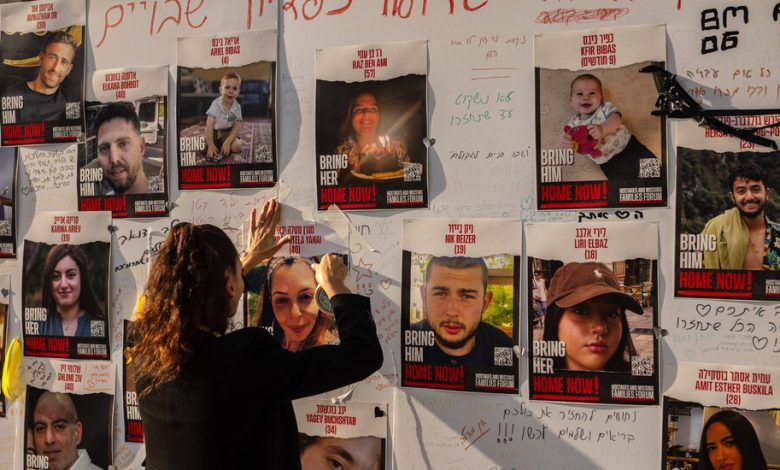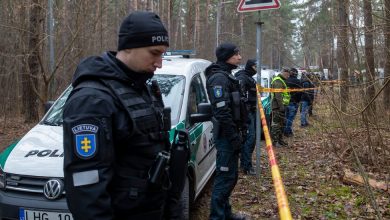Terrible Choices and Deep Distrust: The Path to the Hostage Deal

When it was all said and done, the deal to release some of the hostages held by Hamas came down to two critical phone calls ultimately forcing each side to make a tough concession.
The Israelis were insisting that it was not enough to free just 50 of the roughly 240 hostages. They had to have more, they said. At that point, President Biden had to talk Prime Minister Benjamin Netanyahu of Israel into accepting what was on the table and then keep working to recover the rest.
As for Hamas, according to senior administration officials, its leaders were demanding that the pause in fighting incorporated into the agreement last five days, even though the Israelis refused to agree to more than four. Mr. Biden told the emir of Qatar, who was serving as the intermediary with Hamas, that four was all they would get for now.
The path to the hostage deal was painful and painstaking, one marked by fitful progress, deep mistrust, terrible choices and moments when the whole thing was on the verge of unraveling. Neither side got exactly what it wanted. But if the agreement is carried out successfully over the next few days — and that is still an important if — it could serve as a template for further negotiations to free more of the hostages and extend the temporary cease-fire.
“Last night’s deal is a testament to the tireless diplomacy and determination of many dedicated individuals across the United States government to bring Americans home,” Mr. Biden said on Wednesday on X, the platform formerly called Twitter. “Now, it’s important that all aspects are fully implemented.”
This account is based on senior Biden administration officials, who spoke on condition of anonymity to avoid disrupting the channels of communication.
The effort to free the hostages extends back to the hours following the terrorist attack of Oct. 7, when Hamas gunmen killed about 1,200 people and captured the other 240.
Shortly after the attack, the government of Qatar, a small Gulf emirate that hosts some Hamas leaders but maintains close relations with the United States, approached the White House with information about the hostages and suggested the possibility of a deal to win their release. The Qataris asked that a small group of U.S. officials work secretly with them and the Israelis.
Jake Sullivan, the president’s national security adviser, directed Brett McGurk, the White House Middle East coordinator, and Joshua Geltzer, then the deputy homeland security adviser who has since become the top lawyer for the National Security Council, to take the lead. To preserve secrecy, other agencies were kept in the dark about the initiative.
Mr. McGurk, who has wide contacts in the region, held early morning phone calls each day with the emir of Qatar, Sheikh Tamim bin Hamad al-Thani, and then briefed Mr. Sullivan, who kept Mr. Biden informed. Mr. Sullivan stayed in touch with Ron Dermer and Tzachi Hanegbi, two of Mr. Netanyahu’s closest advisers.
The issue was personal for Mr. Biden, who met with families of Americans who were believed to be among the hostages on a Zoom call on Oct. 13. Mr. Biden extended the scheduled time for the call so each family would have a chance to talk about their missing loved ones. Administration officials who were in the Oval Office or on the line described it as one of the most agonizing moments of the Biden presidency.
On Oct. 23, the White House negotiations with Qatar led to the release of two American citizens, Natalie and Judith Raanan, with Mr. Sullivan, Mr. McGurk and Jon Finer, the deputy national security adviser, tracking what turned out to be a multihour trip out of Gaza in real time from the West Wing. Their release emboldened Mr. Biden and his team to believe that the Qatar channel could lead to the release of more hostages.
The Israelis delegated authority to negotiate to David Barnea, the director of Mossad, the Israeli spy agency. Mr. Barnea began to speak regularly with William J. Burns, the C.I.A. director, about the contours of a deal. Mr. Biden spoke with Mr. Netanyahu on Oct. 20, 22, 23 and 25, each time with the hostages a key topic of the conversation.
Hamas got word to the Americans on Oct. 25 that it had agreed to the parameters of a deal to release the women and children among the hostages, as long as there was a delay of a planned Israeli ground invasion into Gaza. But the Israelis did not view the deal as firm enough to hold back the invasion. Among other things, Hamas had not provided any proof that the hostages were still alive.
But the Israelis adapted their ground invasion to be phased in a way that would allow for a pause in fighting if a deal came together, according to U.S. officials. Over the next three weeks, as Israeli forces moved into Gaza, negotiations continued with Qatar, as well as Egypt.
At one point after Mr. McGurk got off the phone with Qatar’s prime minister, Mr. Biden insisted he wanted to talk with the emir himself. The call, which was not announced publicly, helped shape a deal that was coming together to free women and children in the first phase as part of what would be several stages of release in exchange for the release of Palestinians held prisoner by the Israelis.
The Israelis insisted that the first release include all women and children and demanded proof of life or identifying information. Hamas responded by saying it could guarantee that 50 hostages would be liberated in the first phase but refused to produce a list or even the criteria it was using to determine who would be released. On Nov. 9, Mr. Burns met in Doha, the Qatari capital, with Sheikh Tamim, the emir, and Mr. Barnea, the Mossad chief, to go through the texts of the emerging arrangement.
Mr. Biden called Sheikh Tamim three days later and said “enough was enough,” according to U.S. officials. The Americans and Israelis needed the names or clear identifying information for the 50 hostages who would be released. Without that, Mr. Biden told the emir, there was no basis to proceed. Soon after, Hamas produced identifying criteria for the 50, although the Israelis and Americans believed the criteria would include more than just 50.
Mr. Sullivan met the next day at the White House with families of Americans being held hostage to reassure them all was being done to secure their freedom.
A day later, Mr. Biden spoke with Mr. Netanyahu, who was still pressing for more than 50 hostages. The president urged that he take the deal and then together they would continue to work to free the rest in future stages. The prime minister ultimately agreed, and Mr. Dermer, his adviser, later called Mr. Sullivan to outline the formula preferred by Israel’s war cabinet.
Mr. McGurk saw Mr. Netanyahu that same day in Israel. Walking out of a difficult meeting, the prime minister grabbed Mr. McGurk’s arm. “We need this deal,” Mr. Netanyahu said, and implored Mr. McGurk to have the president call Sheikh Tamim on the final terms.
Hours later, as the deal seemed to be coming together, the talks abruptly halted as communications went dark in Gaza and there was no line to Hamas. Once communications were restored, Hamas broke off the talks, citing the Israeli attack on Al-Shifa Hospital in Gaza, a site the Israelis and Americans say is used by Hamas as a military outpost. Hamas insisted that Israeli forces leave the hospital without searching the grounds. Israel refused but sent word that it would keep the hospital running.
Talks then resumed. Mr. Biden, who was in San Francisco for unrelated meetings with Asian-Pacific leaders, called Sheikh Tamim on Friday and told him this was the last chance and “time was up,” as a U.S. official put it. Hamas wanted a five-day pause in fighting, but the president told him Israel would accept only four and Hamas should bow to that.
Mr. McGurk, who was listening in on the call from the Middle East, met with Sheikh Tamim in Doha the next day to go over the text of the deal. They patched in Mr. Burns by phone after he spoke with Mossad. The six-page deal envisioned women and children coming out in a first phase, including three Americans, but anticipated future releases. The emir passed the proposal to Hamas late that night.
In Cairo the next morning, Mr. McGurk was meeting with Abbas Kamel, the head of Egyptian intelligence, when a U.S. aide brought a message from Hamas leaders accepting nearly all of the terms. Over the course of the next few days, final details were worked out. On Tuesday morning, Hamas informed Qatar that it had approved the deal. Israel’s government met for seven hours that night and signed off, too.
“Today’s deal should bring home additional American hostages,” Mr. Biden said in a statement shortly before midnight on the East Coast on Tuesday, “and I will not stop until they are all released.”




